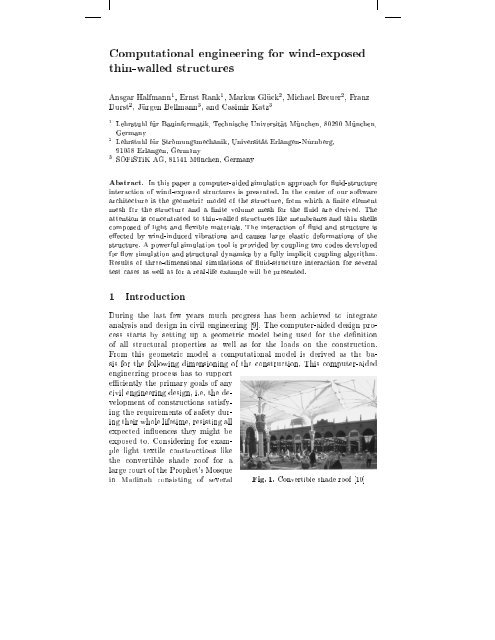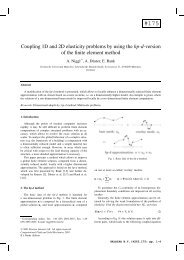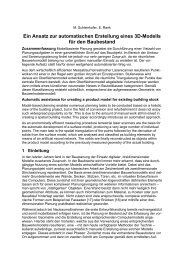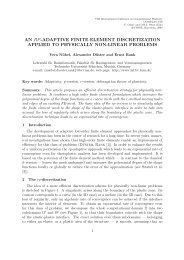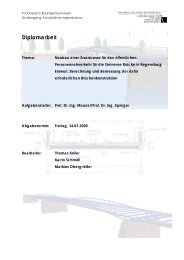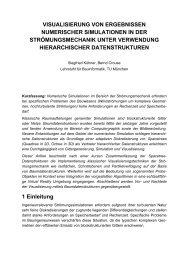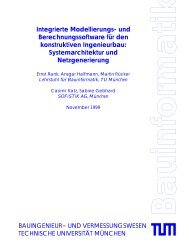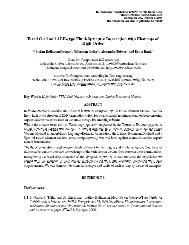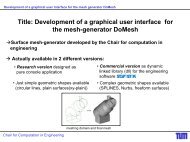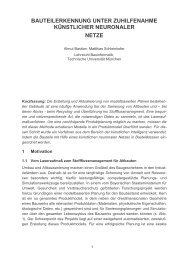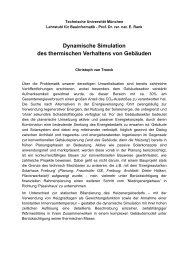Computational engineering for wind-exposed thin-walled structures
Computational engineering for wind-exposed thin-walled structures
Computational engineering for wind-exposed thin-walled structures
Create successful ePaper yourself
Turn your PDF publications into a flip-book with our unique Google optimized e-Paper software.
<strong>Computational</strong> <strong>engineering</strong> <strong>for</strong> <strong>wind</strong>-<strong>exposed</strong><br />
<strong>thin</strong>-<strong>walled</strong> <strong>structures</strong><br />
Ansgar Halfmann 1 , Ernst Rank 1 , Markus Gluck 2 ,Michael Breuer 2 ,Franz<br />
Durst 2 ,Jurgen Bellmann 3 , and Casimir Katz 3<br />
1 Lehrstuhl fur Bauin<strong>for</strong>matik, Technische Universitat Munchen, 80290 Munchen,<br />
Germany<br />
2 Lehrstuhl fur Stromungsmechanik, Universitat Erlangen-Nurnberg,<br />
91058 Erlangen, Germany<br />
3 SOFiSTiK AG, 81541 Munchen, Germany<br />
Abstract. In this paper a computer-aided simulation approach <strong>for</strong> uid-structure<br />
interaction of <strong>wind</strong>-<strong>exposed</strong> <strong>structures</strong> is presented. In the center of our software<br />
architecture is the geometric model of the structure, from which a nite element<br />
mesh <strong>for</strong> the structure and a nite volume mesh <strong>for</strong> the uid are derived. The<br />
attention is concentrated to <strong>thin</strong>-<strong>walled</strong> <strong>structures</strong> like membranes and <strong>thin</strong> shells<br />
composed of light and exible materials. The interaction of uid and structure is<br />
eected by <strong>wind</strong>-induced vibrations and causes large elastic de<strong>for</strong>mations of the<br />
structure. A powerful simulation tool is provided by couplingtwo codesdeveloped<br />
<strong>for</strong> ow simulation and structural dynamics by a fully implicit coupling algorithm.<br />
Results of three-dimensional simulations of uid-structure interaction <strong>for</strong> several<br />
test cases as well as <strong>for</strong> a real-life example will be presented.<br />
1 Introduction<br />
During the last few years much progress has been achieved to integrate<br />
analysis and design in civil <strong>engineering</strong> [9]. The computer-aided design process<br />
starts by setting up a geometric model being used <strong>for</strong> the denition<br />
of all structural properties as well as <strong>for</strong> the loads on the construction.<br />
From this geometric model a computational model is derived as the basis<br />
<strong>for</strong> the following dimensioning of the construction. This computer-aided<br />
<strong>engineering</strong> process has to support<br />
eciently the primary goals of any<br />
civil <strong>engineering</strong> design, i.e. the development<br />
of constructions satisfying<br />
the requirements of safety during<br />
their whole lifetime, resisting all<br />
expected inuences they might be<br />
<strong>exposed</strong> to. Considering <strong>for</strong> example<br />
light textile constructions like<br />
the convertible shade roof <strong>for</strong> a<br />
large court of the Prophet's Mosque<br />
in Madinah consisting of several Fig. 1. Convertible shade roof [10]


